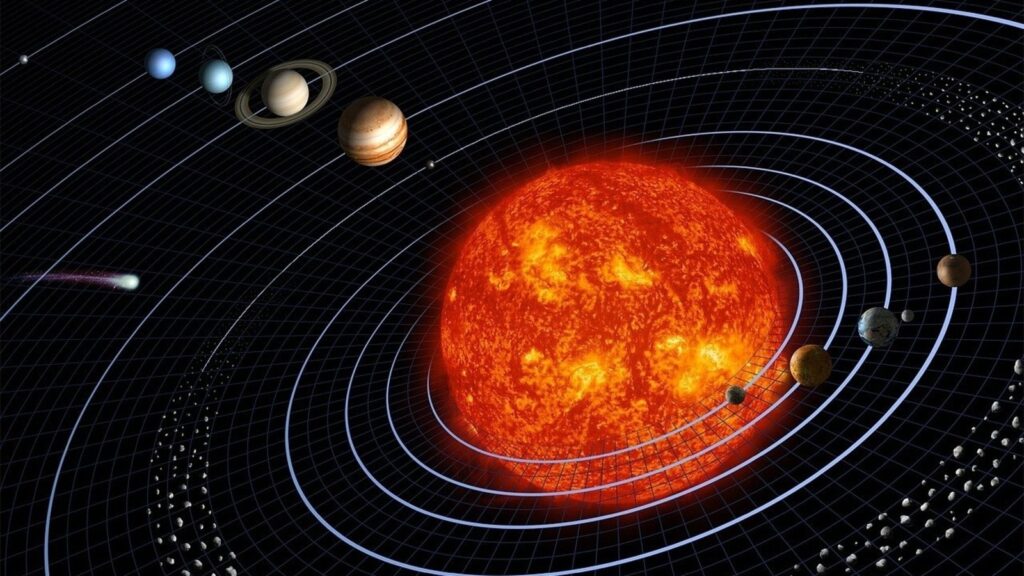
The solar system, a vast expanse of celestial marvels, holds within it a treasure trove of wonders that continue to captivate and intrigue us. From the scorching heat of the Sun to the icy peaks of Pluto, each celestial body reveals a story of cosmic proportions. In this article, we embark on a journey through 25 mind-blowing facts about our solar system that will leave you in awe of the beauty and complexity of our cosmic home.
- Voyager 1’s Interstellar Journey: Did you know that NASA’s Voyager 1 spacecraft, launched in 1977, took over three decades to exit our solar system? It’s currently venturing into interstellar space, a journey that will span thousands of years.
- Planets on Parade: Imagine all the planets in our solar system lined up between Earth and our moon. It’s a tight squeeze, but they could all fit snugly from Mercury to Neptune.
- Uranus, the Sideways Spinner: Unlike its planetary siblings, Uranus rotates on its side, creating extreme seasons with one pole basking in sunlight for over two decades while the other remains shrouded in darkness.
- Io’s Volcanic Symphony: Jupiter’s moon Io boasts hundreds of active volcanoes, spewing sulfur into space and making it the most geologically active moon in our solar system.
- Olympus Mons, the Martian Giant: Mars boasts Olympus Mons, a towering volcano rising 16 miles high and stretching over 374 miles wide, making it the largest volcano in the solar system.
- Valles Marineris, the Martian Grand Canyon: Mars is also home to Valles Marineris, a canyon system 10 times longer than the Grand Canyon, stretching over 2,500 miles.
- Venus, the Windy Inferno: Despite its hellish conditions, Venus boasts hurricane-force winds racing at 50 times its rotation speed.
- Water, Water Everywhere: Water, the elixir of life, can be found across our solar system, hinting at the possibility of extraterrestrial life.
- Exploring the Final Frontier: Over the past six decades, humanity has sent spacecraft to every corner of our solar system, capturing breathtaking images of distant worlds and expanding our understanding of the cosmos.
- Guardians of the Galaxy: As we explore space, we must tread carefully to avoid contaminating potentially habitable worlds with Earthly microbes, preserving the sanctity of our solar system.
- Mercury’s Ongoing Contraction: Despite its small size, Mercury is still contracting, indicating recent tectonic activity and ongoing planetary shrinkage.
- Pluto’s Icy Peaks: Pluto boasts majestic icy mountains, some towering over 11,000 feet high, challenging our preconceived notions of this distant dwarf planet’s geology.
- Pluto’s Puzzling Atmosphere: Pluto’s atmosphere defies expectations, with a haze extending over 1,000 miles high, challenging our understanding of planetary atmospheres.
- Rings Galore: Every outer planet from Jupiter to Neptune boasts its own unique ring system, composed of various materials offering insights into planetary dynamics and evolution.
- Jupiter’s Great Red Spot Diminishing: Jupiter’s colossal Great Red Spot, once a dominant feature, is shrinking, raising questions about the storm’s longevity and underlying mechanisms.
- Sun-Grazing Comets Discovered: Sun-grazing comets, once the domain of amateur astronomers, are now being discovered in droves by NASA’s solar and heliospheric observatory, providing valuable insights into solar interactions and comet dynamics.
- The Quest for Planet 9: Astronomers are actively searching for Planet 9, a hypothetical world hidden at the edge of our solar system, which could explain peculiar orbital dynamics beyond Neptune.
- Neptune’s Energetic Atmosphere: Despite its distance from the Sun, Neptune radiates more heat than it receives, with winds reaching speeds of up to 1,500 mph, presenting a captivating mystery.
- Van Allen Belt Mysteries Unveiled: Earth’s Van Allen belts, zones of magnetically trapped particles, continue to surprise scientists with their dynamic behavior, deepening our understanding of space weather and magnetospheric dynamics.
- Miranda’s Geological Intricacies: Uranus’s moon Miranda boasts diverse geological features, challenging our understanding of moon formation and evolution.
- Saturn’s Yin-Yang Moon: Saturn’s moon Iapetus showcases a stark contrast between its dark and light hemispheres, puzzling astronomers with its intriguing duality.
- Titan’s Methane Seas: Saturn’s moon Titan boasts lakes filled not with water, but with methane and ethane, offering an exciting glimpse into the moon’s exotic chemistry.
- Organic Molecules Abound: Complex carbon-based compounds, the building blocks of life, pervade throughout our solar system, hinting at the possibility of life beyond Earth.
- Saturn’s Hexagonal Storm: A colossal hexagon-shaped storm swirling in Saturn’s northern hemisphere defies conventional atmospheric patterns, captivating astronomers with its mesmerizing beauty.
- The Sun’s Fiery Mystery: In the Sun’s scorching atmosphere, temperatures soar into the millions of degrees, posing a profound cosmic conundrum as scientists endeavor to unravel the mysteries of solar heating mechanisms.
From the outer reaches of the Kuiper Belt to the scorching heat of the Sun, our solar system is a testament to the beauty and complexity of the cosmos. As we continue to explore its wonders, each discovery unveils new mysteries, beckoning us to delve deeper into the cosmic unknown.



GIPHY App Key not set. Please check settings